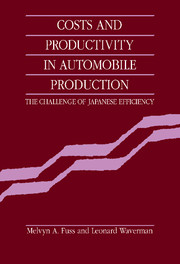Book contents
- Frontmatter
- Contents
- Preface
- Chapter 1 Introduction
- Chapter 2 International differences in output, productivity, and wages in the automobile industry: the 1950s to the mid-1980s
- Chapter 3 The cost-function approach to the analysis of cost and total factor productivity differences
- Chapter 4 Data base sources and method of construction
- Chapter 5 Empirical results: estimation of the cost function
- Chapter 6 Productivity growth in the automobile industry, 1970–1984: a comparison of the United States, Japan, Germany, and Canada
- Chapter 7 International comparisons of automobile industry cost and productivity levels: Japan, Germany, and the United States
- Chapter 8 International comparisons of automobile industry cost and productivity levels: Canadian with U.S., Japanese, and German production
- Chapter 9 Summary and conclusions
- References
- Index
Chapter 9 - Summary and conclusions
Published online by Cambridge University Press: 16 October 2009
- Frontmatter
- Contents
- Preface
- Chapter 1 Introduction
- Chapter 2 International differences in output, productivity, and wages in the automobile industry: the 1950s to the mid-1980s
- Chapter 3 The cost-function approach to the analysis of cost and total factor productivity differences
- Chapter 4 Data base sources and method of construction
- Chapter 5 Empirical results: estimation of the cost function
- Chapter 6 Productivity growth in the automobile industry, 1970–1984: a comparison of the United States, Japan, Germany, and Canada
- Chapter 7 International comparisons of automobile industry cost and productivity levels: Japan, Germany, and the United States
- Chapter 8 International comparisons of automobile industry cost and productivity levels: Canadian with U.S., Japanese, and German production
- Chapter 9 Summary and conclusions
- References
- Index
Summary
In the introduction to this volume we demonstrated how “relative competitiveness” depends on a host of factors such as input prices and exchange rates, as well as on aspects of technical efficiency like economies of scale and country-specific efficiency. We also discussed how trade flows between countries can be influenced by basic relative competitiveness and by policies such as exchange rates, taxes, subsidies, and direct interventions in tariffs, quotas, and Voluntary Restraint Agreements (VRAs). A key issue raised in the first two chapters is the distinction between shortrun temporary dislocations and longer-run fundamental movements. In particular, capacity utilization was singled out as a crucial factor affecting short-run movements in unit cost and productivity in an industry with the capital intensity of automobile production. We also showed how temporary disequilibria in foreign-exchange markets could muddy the analysis of long-run fundamental changes in relative competitiveness.
Chapter 2 provided a historical summary of the absolute and relative movements in automobile production: the values of output and input (and input prices) since the early 1960s. In 1961, the United States produced 5.5 million passenger vehicles, 2.4 times as many automobiles as the combined outputs of Japan, Germany, and Canada. In 1961, the Japanese produced 250,000 motor cars, or approximately 5% of the number produced in the United States, 15% of the number produced in Germany, and 60% of the number produced in Canada.
- Type
- Chapter
- Information
- Costs and Productivity in Automobile ProductionThe Challenge of Japanese Efficiency, pp. 213 - 232Publisher: Cambridge University PressPrint publication year: 1992



